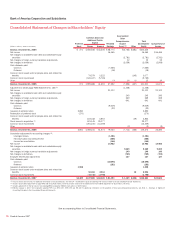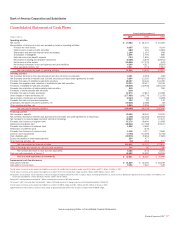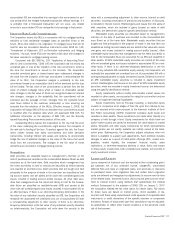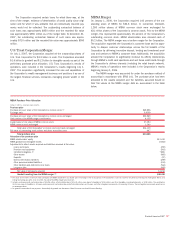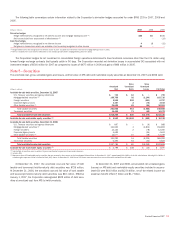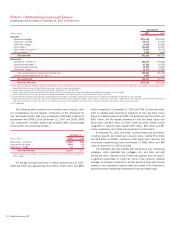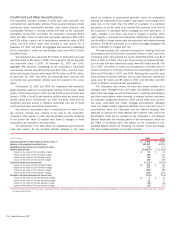Bank of America 2007 Annual Report Download - page 128
Download and view the complete annual report
Please find page 128 of the 2007 Bank of America annual report below. You can navigate through the pages in the report by either clicking on the pages listed below, or by using the keyword search tool below to find specific information within the annual report.
flow hedges are reclassified to income when the hedged transaction
affects earnings. Gains and losses on AFS debt and marketable equity
securities are reclassified to income as the gains or losses are realized
upon sale of the securities. Other-than-temporary impairment charges are
reclassified to income at the time of the charge. Translation gains or
losses on foreign currency translation adjustments are reclassified to
income upon the substantial sale or liquidation of investments in foreign
operations.
Earnings Per Common Share
Earnings per common share is computed by dividing net income available
to common shareholders by the weighted average common shares issued
and outstanding. For diluted earnings per common share, net income
available to common shareholders is divided by the weighted average
number of common shares issued and outstanding for each period plus
amounts representing the dilutive effect of stock options outstanding,
restricted stock and restricted stock units, if applicable. The effects of
restricted stock, restricted stock units and stock options are excluded
from the computation of diluted earnings per common share in periods in
which the effect would be antidilutive. Dilutive potential common shares
are calculated using the treasury stock method.
Foreign Currency Translation
Assets, liabilities and operations of foreign branches and subsidiaries are
recorded based on the functional currency of each entity. For certain of the
foreign operations, the functional currency is the local currency, in which
case the assets, liabilities and operations are translated, for consolidation
purposes, at period-end rates from the local currency to the reporting cur-
rency, the U.S. dollar. The resulting unrealized gains or losses are
reported as a component of accumulated OCI on a net-of-tax basis. When
the foreign entity’s functional currency is determined to be the U.S. dollar,
the resulting remeasurement currency gains or losses on foreign-
denominated assets or liabilities are included in net income.
Credit Card Arrangements
Endorsing Organization Agreements
The Corporation contracts with other organizations to obtain their endorse-
ment of the Corporation’s loan products. This endorsement may provide
the Corporation exclusive rights to market to the organization’s members
or to customers on behalf of the Corporation. These organizations endorse
the Corporation’s loan products and provide the Corporation with their
mailing lists and marketing activities. These agreements generally have
terms that range from five to seven years. The Corporation typically pays
royalties in exchange for their endorsement. These compensation costs to
the Corporation are recorded as contra-revenue against card income.
Cardholder Reward Agreements
The Corporation offers reward programs that allow its cardholders to earn
points that can be redeemed for a broad range of rewards including cash,
travel and discounted products. The Corporation establishes a rewards
liability based upon the points earned which are expected to be redeemed
and the average cost per point redemption. The points to be redeemed are
estimated based on past redemption behavior, card product type, account
transaction activity and other historical card performance. The liability is
reduced as the points are redeemed. The estimated cost of the rewards
programs is recorded as contra-revenue against card income.
Stock-based Compensation
On January 1, 2006, the Corporation adopted SFAS No. 123 (Revised
2004), “Share-Based Payment” (SFAS 123R) under the modified-
prospective application. The Corporation had previously adopted the fair
value-based method of accounting for stock-based employee compensa-
tion under SFAS No. 148, “Accounting for Stock-Based Compensation –
Transition and Disclosure – an amendment of FASB Statement No. 123,”
(SFAS 148) prospectively, on January 1, 2003. Had the Corporation
adopted SFAS 148 retrospectively, the impact in 2005 would not have
been material. For additional information on stock-based employee com-
pensation, see Note 17 – Stock-Based Compensation Plans to the Con-
solidated Financial Statements.
Note 2 – Merger and Restructuring Activity
LaSalle Bank Corporation Merger
On October 1, 2007, the Corporation acquired all the outstanding shares
of LaSalle, for $21.0 billion in cash. As part of the acquisition, ABN AMRO
Bank N.V. (the seller) capitalized approximately $6.3 billion as equity of
intercompany debt prior to the date of the acquisition. With this acquis-
ition, the Corporation significantly expanded its presence in metropolitan
Chicago, Illinois and Michigan by adding LaSalle’s commercial banking
clients, retail customers, and banking centers. LaSalle’s results of oper-
ations were included in the Corporation’s results beginning October 1,
2007.
The LaSalle acquisition was accounted for under the purchase
method of accounting in accordance with SFAS No. 141, “Business
Combinations” (SFAS 141). The preliminary purchase price has been allo-
cated to the assets acquired and the liabilities assumed based on their
fair values at the LaSalle acquisition date as summarized in the following
table.
LaSalle Preliminary Purchase Price Allocation
(Dollars in millions)
Purchase price
$21,015
Preliminary allocation of the purchase price
LaSalle stockholders’ equity 12,495
LaSalle goodwill and intangible assets (2,728)
Adjustments to reflect assets acquired and liabilities assumed
at fair value:
Loans and leases (88)
Premises and equipment (139)
Identified intangibles
(1)
1,029
Other assets (248)
Exit and termination liabilities (339)
Other liabilities and deferred income taxes (72)
Fair value of net assets acquired 9,910
Preliminary goodwill resulting from the LaSalle merger (2)
$11,105
(1) Includes core deposit intangibles of $700 million and other intangibles of $329 million. The amortization
life for core deposit intangibles and other intangibles is 10 years. These intangibles are amortized on an
accelerated basis.
(2) No goodwill is expected to be deductible for tax purposes. The goodwill has been allocated across all of
the Corporation’s business segments.
126
Bank of America 2007


